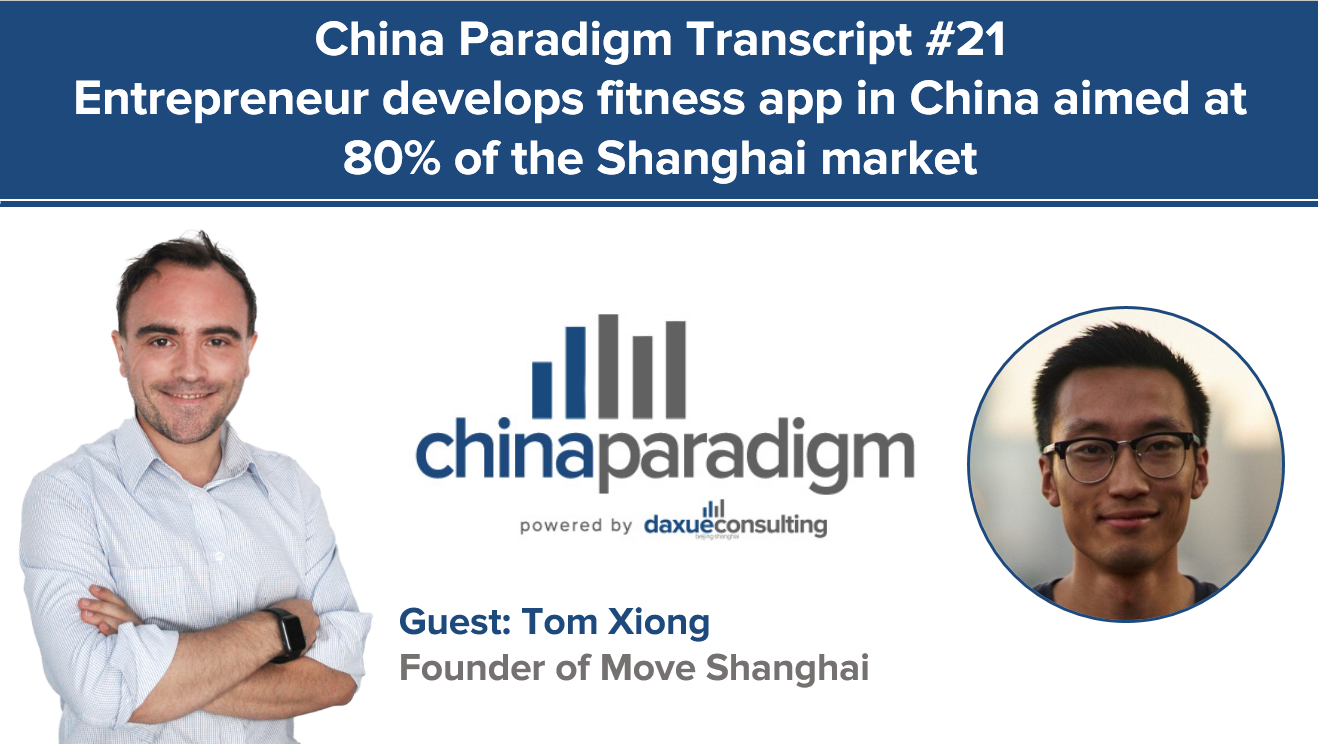This transcript is based on our interview with Tom Xiong, a serial entrepreneur and a key figure in the market for fitness apps in China. He is the founder of Move Shanghai. Move Shanghai is one of the most interesting players in the market for fitness apps in China (explore how and why China’s fitness industry is transforming). Move Shanghai targets those people who want to be fit and healthy but are not loyal to fitness and quit their gym resolutions in late January. Although the market for fitness apps in China is already quite developed, Move Shanghai’s USP is that it targets 80% of the fitness market who do not go to the gym as often as they would like. They do this by offering a diverse array of classes/venues and thus, making the process of going to gyms more stimulating for the passive gym-goer.
Maintaining fitness resolutions is a common problem in the market for fitness apps in China and globally. Move Shanghai maintains and monetizes these resolutions.
Listen to the full China Paradigm #21 episode on Youtube, Apple Podcast, Google Podcasts, Spotify, Soundcloud, or simply continue reading the transcript below.
Here is the transcript from our interview with entrepreneur in market for fitness apps in China, Tom Xiong
Today we are chatting with Tom Xiong. Tom Xiong is the founder of Move Shanghai. Move Shanghai is an exciting entrant into the market for fitness apps in China and is a platform that allows users to purchase packages of workout experiences. They can use their packages across hundreds of different fitness and health venues in Shanghai including swimming pools, gyms, yoga studios, dance classes, and tennis to name but a few of the hundreds of different activities users can choose from.
Move Shanghai’s fitness app makes it easier for these users to stay engaged with their goals because they can move from place to place and try out hundreds of different fitness experiences to find the ones that appeal most to them.
We are excited to talk about how Move Shanghai works, and how they have carved out a niche in the market for fitness apps in China. Also, Tom will hopefully let us know about some of the challenges businesses face in the market for fitness apps in China and how they can be overcome.
How long has Move Shanghai been active in the market for fitness apps in China, and what stage of development is the company at?
Tom Xiong: Since 2015, we are still at an early stage, it took us a while to get product-market fit, but we are growing very quickly. We have about 20,000 members, about 150 fitness venues and we are adding about 20 to 50 new venues a month. Our team is about 10 people.
What business model does Move Shanghai use to compete in the market for fitness apps in China?
We are similar to Spotify. I have an arrangement with the gym/ fitness studio owners and I can get a discounted price because I will be purchasing a lot of packages. Then I sell these experiences to users who can buy a monthly subscription. This gives them access to the available experiences for that month if they want, they can purchase an unlimited package which gives them unlimited access.
But I work on an after-pay model. So, at the end of the month the gym or fitness venue calculates how many Move Shanghai members they had that month. Then I will send them the money based on the previously agreed price between myself and that venue.
The price of the package gets more expensive based on how many venues are available to the users. So, it’s not how many sessions they can access in a month. This is because the people we are targeting are not die-hard fitness fanatics and are unlikely to use their packages on a daily basis. In the market for fitness apps in China, about 80% of the market are those who are new or not very loyal to maintaining fitness habits.
The reason we didn’t use a profit-sharing model is that the paid fitness market in Shanghai is very immature. The price of a fitness experience in Shanghai can vary massively from one district to another.
How do you set your pricing to compete in the market for fitness apps in China and what packages do you offer?
We offer 2 main packages, Basic and Universal which cost 999 RMB and 1,499 RMB respectively. Also, you can pay a flat fee (88 RMB) per use package. Each of the 2 main packages enables the user to try 10 different locations per month, however, there are more venues available in the Universal package.
What are some of the challenging issues Move Shanghai faces in the market for fitness apps in China?
Well before we partner with any venue, we do some analysis on them and of course we try to on-board the staff. We have a dashboard they use to see who is coming and at what time they are coming in. Also, we have to integrate our booking system with their booking systems and reception software.
What is the best platform for entrants into the market for fitness apps in China?
Initially, we just used an iOS app because we felt that’s what most of our users had and we wanted to control our spending. And we built a mobile-friendly website that allowed Android users to access us. However, we haven’t updated our iOS in more than 6 months and we decided not to launch our android app because we wanted to focus solely on a fitness WeChat mini-program. We still have a lot of product development to do and are moving all of our users onto the fitness WeChat mini-program because we can do more updates with fewer employees. So, with iOS, we released an update every month but with a fitness WeChat mini-program, we can release several updates every week with fewer people working on it.
WeChat mini-programs work well for us because we offer a simple list of available experiences. I think it’s easier to make a beautiful experience in iOS but our fitness WeChat mini-program is highly functional.
How did you raise the money to enter the market for fitness apps in China?
At the start, we raised angel funding of a few million RMB. To date we have raised just under 10 million RMB. We turned cash flow positive after about 2 years and we haven’t raised any funding since then. To be honest, we’re not really looking to. The reason is that we are a paid service so we make money every month and we don’t have to rely on a magical IPO payday to make bank.
We are growing organically and growing quite quickly in the market for fitness apps in China. Our team is trying now to develop the 2c side of the business because as soon as we have users, we know how to monetize them and we know what to show them. We just need to start getting millions of users in rather than getting 10s of thousands of users in. We turned down a few VC deals around a year and a half ago.
What’s your strategy in terms of customer acquisition in the market for fitness apps in China?
What we see is that is that it’s very hard to sell fitness on its own. What we have found is that when we do co-marketing, co-sales, and co-branding with everything from F&B to Yoga clubs, it’s easier to get people to continue committing to their fitness goals. Recently, we did some co-branding with a famous clothing brand. Because I work with over 150 fitness venues, I can negotiate with a very large famous clothing brand.
What are some of the pain points and the major drivers for customer acquisition in the market for fitness apps in China?
There are 2. First, creating a space for people to learn about fitness easily. And the second is to make the user feel they are not risking anything and to make them feel 100% comfortable before they go to a class. Making them feel that Move Shanghai is a new experience that they want to try out that might be fun and if it’s not fun they can always try something else out. If you can solve the pain points, you can retain customers.
As a fairly new entrant in the market for fitness apps in China , is it worth it for Move Shanghai to cooperate with corporate companies?
No, because our price is a premium price and not all the employees of an average corporate sized company can afford our price. Because these corporates will want to pay us a flat fee for all their employees and that is too low for us right now. However, we will host events at these corporate companies and this raises our brand awareness.
How did your past experience lead you into the market for fitness apps in China?
I was born in China. When I was 6, I moved to Sweden. As a teenager, I started coding and I built a few internet companies in Sweden. After selling my last one I moved to New York to do some intrapreneurship with a company. After that, I decided I wanted to come to China. I didn’t know what I wanted to do at the time but I wanted to come and live and work in Shanghai. Throughout this time, I’ve been doing a lot of consultation and advisory work with multinational brands, advising them on their China strategy.
What’s your opinion on the Chinese diaspora coming back to live and work in China?
There are about a million young Chinese people who were born in China but educated overseas returning to China each year. I think it is on a parallel with Silicon Valley and I did a podcast on this recently. However, the 996 debacles really damaged China’s tech reputation.
How do you keep up to date with issues in China?
That’s the main reason I started doing my own podcast. Through that, I get to talk with lots of interesting people who are experts, which informs my decision-making better than just reading articles.
‘This transcript is a sample of our China Paradigm podcast interview with Tom Xiong, founder of Move Shanghai. To continue learning about the market for fitness apps in China, find the full episode on Youtube, Google Podcasts, Soundcloud, Apple Podcast, and Spotify.’





